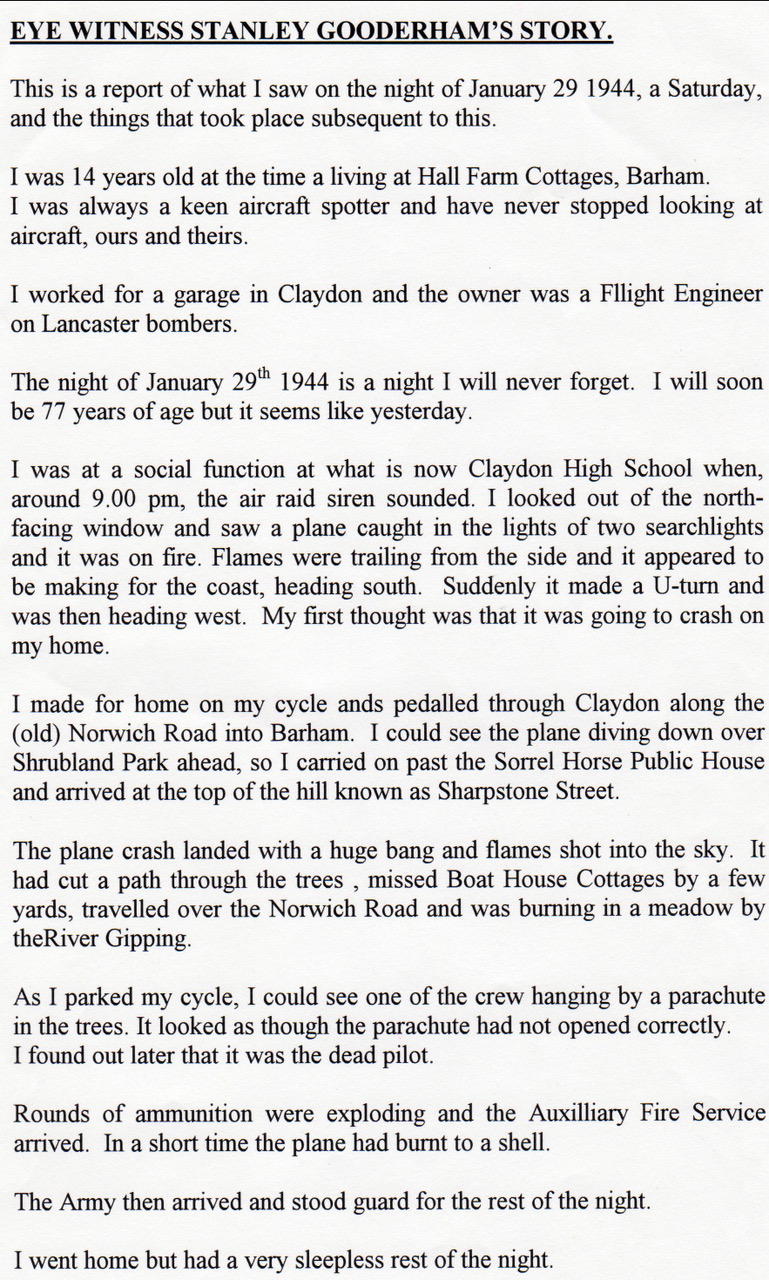Stanley Gooderham
Recollection of pedalling, a plane crash and a parachute.
Updated: 7/4/2021: Additional copy
This is a report of what I saw on the night of January 29 1944, a Saturday, and the things that took place subsequent to this. I was 14 years old at the time a living at Hall Farm Cottages, Barham.
I was always a keen aircraft spotter and have never stopped looking at aircraft, ours and theirs. I worked for a garage in Claydon and the owner was a Flight Engineer on Lancaster bombers.
The night of January 29th 1944 is a night I will never forget. I will soon be 77 years of age but it seems like yesterday.
I was at a social function at what is now Claydon High School when, around 9.00 pm, the air raid siren sounded. I looked out of the north facing window and saw a plane caught in the lights of two searchlights and it was on fire. Flames were trailing from the side and it appeared to be making for the coast, heading south. Suddenly it made a U-turn and was then heading west. My first thought was that it was going to crash on my home .
I made for home on my cycle ands pedalled through Claydon along the (old) Norwich Road into Barham. I could see the plane diving down over Shrubland Park ahead, so I carried on past the Sorrel Horse Public House and arrived at the top ofthe hill known as Sharp stone Street.
The plane crash landed with a huge bang and flames shot into the sky. It had cut a path through the trees , missed Boat House Cottages by a few
yards , travelled over the Norwich Road and was burning in a meadow by theRiver Gipping.
As I parked my cycle, I could see one of the crew hanging by a parachute in the trees. It looked as though the parachute had not opened correctly. I found out later that it was the dead pilot. Rounds of ammunition were exploding and the Auxilliary Fire Service arrived . In a short time the plane had burnt to a shell.
The Army then arrived and stood guard for the rest of the night.
I went home but had a very sleepless rest of the night.
The following morning, I went back to the plane, a German Junkers 88 and found a section that had fallen away and caught in a hedge. I took it home with me. Later an Italian POW made me a cigarette case from it, carving by hand.
Years Later…
For many years afterwards I could see the pathway the plane had cut through the trees. This always reminded me of the happenings of that night.
It was not until 1988 that a friend of mine, Ted Valentine, who was a keen metal detector, suggested that we should go over the site with his detector. We obtained permission from the farmer and spent a day examining the meadow. We found many small parts of the Junkers in spite of the land having been ploughed several times. These parts and my account were later passed to the Flixton Air Museum.
Over the next few weeks, I found more and more about the crew, where the bombing raid had started from and what the target was. This turned out to be Silvertown Docks in London. Things had gone wrong for the crew who found they were off course and had arrived north-east of Colchester. It was around here that they met with a British night fighter on a training flight and their plane was set on fire by a short burst of machine gun fire. While heading back to the coast some of the crew baled out over Needham Market.
I wrote to the German Aircrew Pensions Office (My wife was a great help as she was German) and found that the observer was still living, and they also informed me that the pilot had been killed. They had no trace of the rest of the crew. The pilot had been laid to rest in a churchyard in Needham market, where he was buried with full military honours, which included a band which marched up Needham High Street. His body was later removed to the German Military Cemetery at Cannock Chase. I have visited there and found his grave.
I wrote to the German Aircrew Pensions Office again and they very kindly gave me the address of Under-Officer Jurgens, the observer, who was still alive and happy to hear from me. I sent him a small part of the plane in which he had travelled in so many years ago. I had a letter from him telling me that he had smashed both knees on landing by parachute and had to learn to walk like a child again. When he was fit again, he was sent to America and worked in Wyoming. He was sent back to his home country late in 1946. He became a Professor of Engineering, married, and had two boys and they lived just outside Berlin.

0 Comments